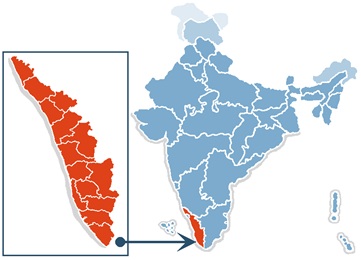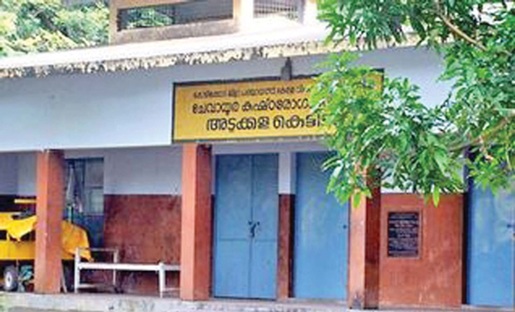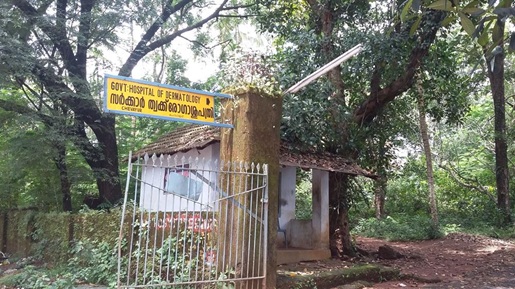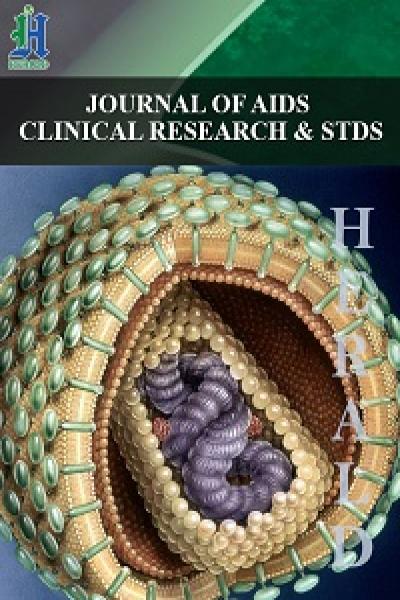
Basel Mission and Leprosy in Kerala during the Colonial Period: A Brief Study
*Corresponding Author(s):
Tiasa Basu RoyDepartment Of History, Visva-Bharati University, Bolpur, Santiniketan, West Bengal, India
Email:tiasabasuroy3@gmail.com
Abstract
Leprosy is an infectious disease that results to several skin ailments, which if treated in its early stage, can be curable. But, due to its awkward appearance on skin, people generally treat this disease as ‘abnormal’ and ‘abominable’ at the same time. Leprosy inflicted people are therefore, marginalised in their social sphere and make them isolated in the community. Its negative impact extends from physical terms to personal life altogether, and turns the lepers’ social standing equivalent to that of an ‘untouchable’. Mostly due to lack of medical facilities and treatment, people succumbed to the claws of leprosy for which myths and misconceptions wove around this disease. However, with the advent of the Protestant missionaries and medical practitioners with them, diseases were treated more ‘scientifically’ by applying medicines and ‘modern techniques.’ This paper will briefly study about leprosy in Kerala, the role of the Basel medical missionaries and the Leprosy Hospital in Chevayur in treating the disease, and taking an attempt to alter the perceptions regarding leprosy among the people.
Keywords
Leprosy; Disease; Kerala; South India; Medical Mission; Basel missionaries
Introduction
Medical knowledge is the epicentre of the history of medicine and public health, and consists of the knowledge of body and its surroundings, its behaviour and recognition [1,2]. In this context, the role of a physician was not just about medical expertise, but long-term carriers of improvements for the indigenous societies and cultures [3]. In India, it is believed that the origin of disease was the ‘low, marshy, and alluvial soil content of the earth’ i.e., the ideal ‘breeding ground’ for all sorts of virus and bacteria [1,2]. However, for the Western medical practitioners, British colonies like India, provided a wide range of medicines, most of which comprised of botanical remedies, i.e., Ayurveda or Yunani epistemes of medical assistance, and were not commonly available in Europe [4,5]. So, health care comprised of:
- Local medical system, comprising of different forms of ‘popular or folk’ medicine
- three episteme of medical practice Ayurvedic, Siddha as well as Unani medicines introduced in India.
- Cosmopolitan allopathic or western medical system [6].
It was basically with the hands of Protestant missionaries from the nineteenth century onwards that, Medical Mission and Western medicines were introduced in different regions of the Indian subcontinent. This resulted in introduction of scientific methods for diagnosing diseases, and provide both preventive and curative methods for it. Alongside, there was an increase in the number of doctors visiting the country, and establishment of hospitals and dispensaries as well [7]. In the 1890s, there was establishment of a new tropical medicine based on the ‘germ theory of disease’, which intensified the state medical intervention, which reached its zenith with the measure taken during the Indian plague epidemics of the 1890sand 1900s. Gradually, Western medicine began to serve an expanded notion of public health and infiltrated the lives of an influential section of the Indian population, and became one of the strongest expressions of ‘colonial political and cultural hegemony’ [4].
This paper will look into the brief history of how the Basel Mission tried to combat and perceived Leprosy, a disease that was equivalent to a ‘social taboo’ in Kerala. In this regard, the role of Leprosy Hospital in Chevayur will be emphasised in curing the patients. This study is mainly based on archival sources and secondary pieces of literature that are pertinent to my theme.
 Figure 1: The red coloured zone is the state of Kerala, India.
Figure 1: The red coloured zone is the state of Kerala, India.
Ailments And Diseases In Kerala
Geographically, located in the southwestern Malabar Coast of India, Kerala (Figure 1) lies in the extreme of the Southwest peninsula of India, situated between the Western Ghats on the east and the Arabian Sea on the west. Although known as ‘God’s Own Country’1, the state of medical condition in Kerala started to improve after the advent of the Christian missionaries, who along with their medical practitioners, embarked in the country for both evangelisation and healing the sick. The common type of ailments that inflicted people were typhoid, plague, cholera, smallpox, indigestion, dengue, skin-diseases, ulcers, and sore eyes. Patients, suffering from typhoid fever, were given hydropathic treatment by the medical missionaries, which was unknown to the residents. The ‘native’ idea was to apply heat to counteract fever, for instance, a hot iron to the head. To talk about an incident, a father brought a little boy to the hospital. After trying all indigenous medical applications, he was still suffering from dropsy. There were red marks all over his body, and the father confessed that it happened from hot iron! [8]. Apart from these, there were even patients who were supposed to have been exorcised by some evil spirits, and was cruelly treated by their relatives out of superstitious beliefes. To encounter those was another diverse experiement for the medical practitioners [9].
However, the most challenging for the medical experts was to deal with leprosy among the people. Before getting into how the Leprosy Asylum or Hospital in Chevayur treated its patients, let us briefly discuss about what leprosy is all about, and how people of south India conceived this disease.
Leprosy As A Disease In South India
South Indians considered leprosy as one of the worst diseases a person can ever get. People’s reaction to this particular malady gave rise to fear, resentment and social rejection to those who have suffered. The victims are often labelled as ‘deviant, blemished, discredited and spoiled’, and this was how stigmatisation developed around leprosy2. Perceived as a threat to the hygienic, moral purity, of ‘normal’ people, the illness was conceived as physically and morally contagious, and its devastating impact on the aesthetics of the body was exemplified as warning to those who had association with the leper patients [10].
A well-known Telugu poem has enumerated the pain associated with leprosy in the following words:
‘Soon my body will lose sensation.
Then black spots will appear all over.
The skin will thicken, and blisters will break out.
I will feel weakened, and turn ugly.
Flies will hover around my oozing pus and blood.
People will turn away in disgust when I beg for food.
So let me go now, while I can still walk,
To look for Kailasa. There is no escaping
God’s words.3
Stigmatisation has been ascribed to the physical manifestations of leprosy [11,12]. In its advanced stages, it came out with foul smelling ulcers and created deformities of the patients’ hand, feet, and face. The devastating effects of the disease influenced the aesthetic appeal of the body, i.e., a change in bodily attractiveness, or a deviation from the generally accepted ‘cultural image of the body’, affected social interactions between leprosy patients and others. The visible marks led to social stigmatisation [13]. Therefore, the patients suffering from leprosy were ‘marked’ as ‘socially unacceptable’ people.
People considered leprosy as follows: ‘ they (i.e., social workers in the leprosy hospital) talk about what causes it (i.e. leprosy). Many different kinds of germs spread in the wind/air and they may enter through the nose and soak into our body. They attack because our resistance is low. When the blood near our nose is string it will drive away the bad germs so that we can inhale healthy air. But because we do not have strength we fall ill.’ Many also believed that mosquitoes, unclean drainage water, failure to boil drinking water or to wear slippers, as possible causes of leprosy and/or carriers of leprosy bacteria [10]. Leprosy in south India was classified as ‘hot’ like other skin complaints, which manifested through boils, blisters, ulcers, swellings, and fever, and interpreted as eruptions of heat through the skin. Patients were even reluctant to talk about the disease. Generally they referred to their own and other patients’ conditions as ‘it’ ‘this’ ‘that’ or used rather vague indications like ‘such a disease’ ‘such a hospital’ ‘some kind of hospital’ or ‘like me’ ‘our people’ [10]. Leprosy was usually seen as an impure affliction and its victims as unclean4. The dimension of leprosy’s impure status went beyond the matter of hygiene: “in the southern regions of India leprosy is more frequent and the people affected by it are Naidus, cobblers and SCs [Scheduled Castes, HMB]. [A] human being should be natural. If he behaves unnaturally, automatically some symptoms will come about. In the case of SC’s their food is of very poor quality. It is taken from dirty places, such as the muck heap, where they collect the decay pf cows and animals and which is used as fertiliser. In that area some eatable plants- kirai- will grow. These plants are having infections. The village people don’t know this, because they are illiterate and uneducated. They cut it, take it home, cook it and drink or eat it. They get also infected. While doing all these things, they are also having more sexual feelings. For enjoyment they used to go to some dirty girls. They did not shave properly, nor comb their hair or take oil bath. So they soon got the symptoms. All this results in showing patches on the skin. Day by day it is growing when not treated by hospital or private doctor. Due to some religious ideas they do not do anything about it. They simply do not care. At last they lose fingers and toes. Only then they will realise that there were symptoms. Like this leprosy is coming. If these symptoms are not there, you will not get the disease”. In the mythological accounts about leprosy, the victim’s impure status could be redeemed if he or she was healed through bathing in the sacred waters of a temple tank, or a lake, or a river, or through contact with fire. Both water and fire were considered as elememts of purification, especially in ritual ceremonies5. It also implied that leprosy’s impure status was the result of a sin committed by its bearer, and ‘a disease which is specially regarded as a punishment or sin, a Hindu affected by this disease remains an outcaste until he can afford to undertake a purification ceremony’ [14]. Leprosy was quite often perceived by patients and villagers as a punishment for a ‘sin’ or mistake committed by the sufferer [15]. So, leprosy was categorised as ‘untouchability’ among the people.
Allopathic medicine propagated leprosy as a ‘mildly infectious, non-hereditary, curable disease’ which is caused by a bacillus called Mycobacterium leprae, which affected nerve extremities. During the initial stages of the infection, the disease usually manifests itself in the form of discoloured, insensitive patches on the skin, and the most visible characteristic of this disease are the contraction of fingers (claw hand), the dysfunction of muscles resulting in a so called drop-foot, and severe ulceration. The mode of transmission of the bacilli is not yet known for certain, but three possible routes might be, the skin, the gastro-intestinal tract, and the respiratory tract [16,17].
Basel Mission And The Leprosy Hospital In Chevayur
Basel Mission, a Protetstant denomination known for its industrial pursuits (‘towel mission’), providing a livelihood for the people, also took up issues of health and medical care for the people of Kerala [18]. Besides curing ‘general’ ailments, the Basel medical misisonaries took speacial care of the leprosy inflcted patients. They had established the Leper Hospital (Figures 2 and 3) at Chevayur in Kozhikode, Kerala (which in 1978 has been taken up by the Government of Kerala), and started treating and rehabilitating the ‘ostracised’ lepers with medicine, love and care. Some of them even converted to Christainity after witnessing the healing power of the Lord. Dr. Schneiter stated: ‘if there is one branch of Mission work which meets with universal approval and sympathy among Christian and non-Christians alike, it is the mission among the lepers; and if there is a branch of work which affords excellent opportunity for evangelisation, unhampered by any obstruction, it is, indeed the Mission among the Lepers. For the patients in this asylum have broken off their connections with the outside world, and are therefore no longer subjected to the influences of their former surroundings, but on the contrary, constantly live in a Christian atmosphere, and the Word of God is abundantly dispensed to them at the morning and evening prayers. In course of the past year, seventy-five lepers were treated in the asylum. The average daily number of patients was forty-nine as against thirty-four in the previous year. 3/4th of them were men and 1/4th women. Classified according to race and religion, there were thirty-four Hindus, thirteen Muslims, and twenty-eight Christians. Nine of the latter had been converted from heathendom in the asylum and received baptism.’ [19]. Another missionary report of 1913 documented that ninety-three lepers were treated with 18,083 dieted days, and in the last year, twelve of the lepers, nine men and three women, embraced Christianity. Ten of them were even baptised on Christmas. The experience with ‘Aioumi’, the medicine against leprosy which Mr. Delord, a missionary in Africa had prepared and tried, had been very satisfactory on Indian patients as well. The base of the medicine was Chamulga oil. The condition of all the patients coincidentally improved after applying ‘Aioumi’. But, the only disadvantage was its costliness. However, liberal donations were made by friends of lepers which enabled to procure more of this valuable medicine [20]. The question as to whether the lepers could entirely be cured of their disease, the answer was negative. But it was a happy news that real progress in the experiment, which were carried on during nine months with the Lepra serum ‘Leprolin’, resulted in a substantial improvement of the two patients who submitted to the cure [21]. The leprosy patients were also given eucalyptus oil and its application produced positive results. The lepers themselves called it a ‘good medicine’ [22]. In the Leper Asylum, the patients who remained for a sufficiently long time under proper care and treatment, were gradually becoming better, and some of them could be hardly recognised as lepers by the outsiders, i.e., their physical deformities could be cured. After having experienced the regenerating power of the medicines (which for them was the blessings of the Holy Spirit), the fear towrads leprosy started to dwindle from people’s mind, with a hope of getting better after complying the doctor’s advices. The Leper Hospital in Chevayur was tranformed into a lovely green area divided into different tracts which were allotted to and cultivated by the patients themsleves, those who were able to move about [23]. Dr. Liebendorfer reported: “every morning, there is prayer in the sick-rooms, after which the patients are attended to. Then the dispensary is opened with a short prayer, and the out-door patients are served” [24-31]. 
Figure 2: Government Leprosy Hospital at Chevayur, Kozhikode.
 Figure 3: Govt. Hospital of Dermatology was started by German Missionaries with a view to provide treatment and rehabilitation to the ostracised leprosy patients. In the year 1978, the institution was taken over by Govt. of Kerala.
Figure 3: Govt. Hospital of Dermatology was started by German Missionaries with a view to provide treatment and rehabilitation to the ostracised leprosy patients. In the year 1978, the institution was taken over by Govt. of Kerala.
Conclusion
Wellesley Bailey was the founder of the Mission to Lepers in India, and he narrated that leprosy asylums were formed in response to a complex combination of impulses: missionary, medical, and political. He joined the American Presbyterian Mission at Ambala, in Punjab, and it was there where he first encountered with people afflicted by leprosy. At the centre of all these endeavours was to ensure a provision of shelter for persons with leprosy that accorded with good stewardship and took the form of judicious use of donations provided by benefactors. Leprosy asylums have generally garnered an impression that those are ‘sites of isolation and suffering.’ Michael Foucault described these places in Europe as: “in the margins of the community, at the gates of cities, there stretched wastelands which sickness had ceased to haunt but had left sterile and long uninhabitable. For centuries, these reaches would belong to the non-human. Leprosy withdrew, leaving derelict these low places”. Both Sanjiv Kakar and Jane Buckingham have independently provided studies of the leprosy asylum in India. Kakar argued that in the light of medical uncertainties about transmission and causation of the disease, asylums were shaped by religious and medical intentions. Buckingham in her study on leprosy in colonial south India in the period before missionary anti-leprosy activity, described the emergence, function, and design of the leprosy hospital in Madras.
The Lepers Act of 1898 was passed by the Governor-General of India in Council. It was described as “An Act to provide for the segregation and medical treatment of pauper lepers and the control of lepers following certain callings.” In it a “a leper” was “any person suffering from any variety of leprosy in whom the process of ulceration has commenced”6. In our case study, we have found that the Basel medical missionaries, although had their primary prerogative towards gaining Christian converts among the people of Kerala, carried out health treatments and experimented with medicines to cure the ailing patients. Leprosy, which was such a sensitive issue in south India, was taken care of by the medical practitioners with sympathy and compassion. They did not treat the leprosy patients as ‘untouchables’ and catered to their proper treatment in the hospital. Unlike Foucault’s understanding of a leper’s home, the hospital in Chevayur was neither a secluded place, nor were the patients treated badly over there. Today, the leading Leprosy Home and Hospital. On the west coast of southern India, with its modern medical equipment, good orthopaedic work, outdoor dispensaries for treatment; and with a related follow-up centre for discharged patients, for which the local Church has taken the responsibility, is the one in Chevayur.
1https://www.mapsofindia.com/maps/kerala/ (accessed on 05.03.2021).
2Leprosy reduced its victims to pauper status, irrespective of their pre-leprosy lives. Apart from physical deformities, the disease brought about a traumatic alteration in a person’s social status and identity. This has been vividly described in A.T.W. Simeons’s novel The Mask of a Lion.
3This poem is translated from the Telugu Sri Kalahastimahatmyamu by Dhurjati, and is taken from Bruin’s book Leprosy in South India.
4Similar perceptions exited in Europe, when the leprosy sufferer was considered as unclean by the society and by the Church, and was expected to live in a lazar or hospital situated outside the city wall (Yawalkar 1986, p.14).
5The waters of Kaveri river are said to have healing powers, especially for skin diseases (Ramanujan 1986, p.96).
6For details see, Jane Buckingham (2002).
References
- Kumar D, Basu RS (2013) In Medical Encounters in British India. New Delhi: Oxford University Press.
- Kumar D (2013) Probing History of Medicine and Public Health in India: A Study of Encounters and Multiple Sites. In Medical Encounters in British India. New Delhi: Oxford University Press.
- Arnold D (1996) Warm Climates and Western Medicines. Amsterdam: Rodopi.
- Arnold D (1993) Colonizing the Body: State Medicine and Epidemic Disease in Nineteenth-Century India. Berkeley and Los Angeles: University of California Press.
- Mark H (2013) From Bazaar Medicine to Hospital Medicine. In Medical Encounters in British India. New Delhi: Oxford University Pres
- Dunn FL (1976) Traditional Asian Medicine and Cosmopolitan Medicine as Adaptive Systems. In Asian Medical Systems. Berkeley: University of California Press.
- Rossella C, Mantovanelli FG (2015) Long Term Effects of Access to Health Care: Medical Mission in Colonial India.
- 64th Report of the Basel German Evangelical Mission in South-West India for the year 1903, 1904. Mangalore: Basel Mission Press.
- 58th Report of the Basel German Evangelical Mission in South-West India for the year 1897, Mangalore: Basel Mission Press.
- Bruin, Hanne M. De (1996) Leprosy in South India: Stigma and Strategies of Coping, Pondicherry: French Institute.
- Mohamed, Abu Ahmed H (1985) Leprosy- the Moslem attitude. Leprosy Review 56: 17-21.
- Ramanujan AK (1986) Two realms of Kannada Folklore. In Another harmony: New Essays on folklore of India. Berkeley: University of California Press.
- Jones EE, Farina A, Hastorf AH, Markus H, et al. (1984) Social Stigma. The Psychology of Marked Relationships. New York: W.H. Freeman and Company.
- Crooke W (1896) An Introduction to the Popular Religion and Folklore of Northern India, 2 volumes. Allahabad: Government Press, North-Western provinces and Oudh.
- Ramu G, Dwivedi MP, Iyer CGS (1975) Social reaction to Leprosy in a Rural Population in Chingleput District (Tamil Nadu). Leprosy in India 47: 156-169.
- Joplin WH 1971 (1978) Handbook of Leprosy. London: William Heinemann Medical Books Ltd.
- Yawalkar SJ (1994) Leprosy for Medical practitioners and Paramedical Workers. Basle: Ciba-Geigy.
- 67th Report of the Basel German Evangelical Mission in South-West India for the year 1906, 1907. Mangalore: Basel Mission Press.
- 70th Report of the Basel German Evangelical Mission in south-west India for 1909, Mangalore: Basel Mission Press.
- 74th Report of the Basel German Evangelical Mission in south-west India for 1913, Mangalore: Basel Mission Press.
- 73rd Report of the Basel German Evangelical Mission in south-west India for 1912, Mangalore: Basel Mission Press.
- 57th Report of the Basel German Evangelical Mission in South-West India for the year 1896, Mangalore: Basel Mission Press.
- 56th Report of the Basel German Evangelical Mission in South-West India for the year 1895, Mangalore: Basel Mission Press.
- 53rd Report of the Basel German Evangelical Mission in South-West India for the year 1892, Mangalore: Basel Mission Press.
- Wellesley B (1924) Fifty Years Work for lepers, 1874-1924. London: Mission to Lepers.
- Robertson J (2009) The Leprosy Asylum in India: 1886-1947. J Hist Med Allied Sci 64: 474-517.
- Simeons ATW (1952) The Mask of a Lion. New York: Alfred A. Knopf.
- Foucault, Michael (1988) Madness and Civilisation: A History of Insanity in the Age of Reason. New York: Random House.
- Kakar S (1996) Medical Developments and Patient Unrest in the Leprosy Asylum, 1860 to 1940. Soc Sci 24: 62-80.
- Kakar S (1996) Leprosy in British India, 1860-1940: Colonial Politics and Missionary Medicine. Med Hist 40: 215-230.
- Donald MA (1965) An Inn Called Welcome: The Story of the Mission to Lepers 1874-1917. London: The Mission to Lepers.
Citation: Roy TB (2021) Basel Mission and Leprosy in Kerala during the Colonial Period: A Brief Study J AIDS Clin Res Sex Transm Dis 8: 032
Copyright: © 2021 Tiasa Basu Roy, et al. This is an open-access article distributed under the terms of the Creative Commons Attribution License, which permits unrestricted use, distribution, and reproduction in any medium, provided the original author and source are credited.

